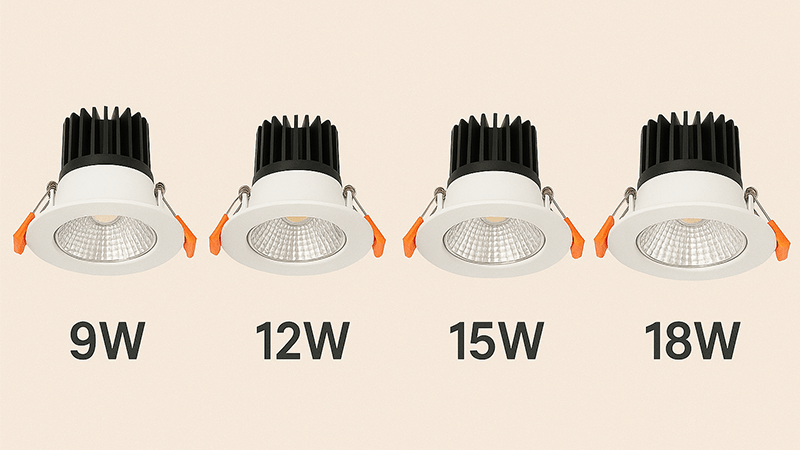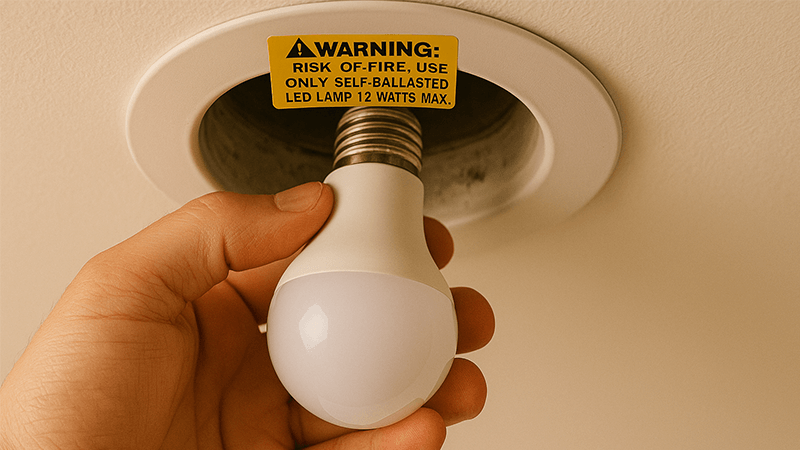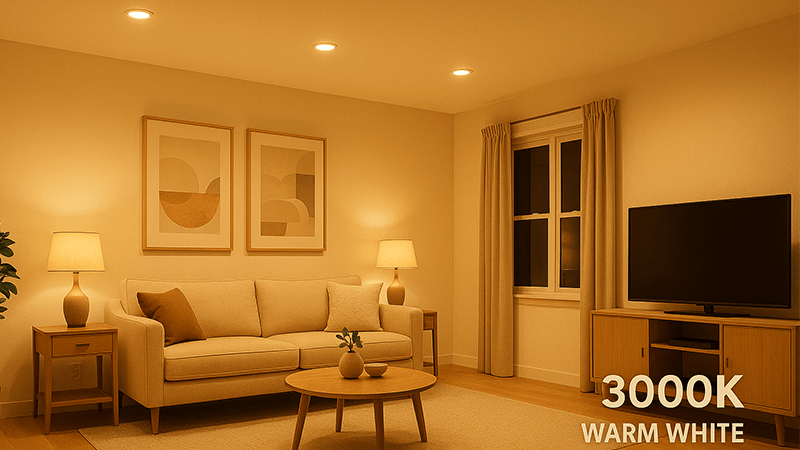Choosing the wrong downlight wattage can leave your space feeling like a cave or a clinic. I’ll help you find that perfect glow without the guesswork.
The right LED downlight wattage depends on lumens, not watts. For most living spaces, an 8-12W downlight providing 700-1100 lumens is a great choice. Think lumens for brightness first, then find the wattage that delivers it efficiently.

For over a decade in the lighting industry, I’ve seen the same confusion time and again. People are still stuck thinking about watts like we did with old incandescent bulbs. But with LEDs, the rules have completely changed. It’s a simple shift in thinking that makes all the difference between a lighting project that fails and one that wows your clients. I want to walk you through this new way of thinking. It will save you time, money, and a lot of headaches on your next project. Let’s break it down together, step by step, so you can choose your next LED downlight with total confidence.
What wattage is best for LED downlights?
Are you staring at dozens of wattage options, feeling lost? Picking the "best" one feels like a random guess, but it doesn’t have to be.
There is no single "best" wattage. The ideal choice depends on your room’s function, size, and ceiling height. Generally, 8-12W is great for ambient light, while kitchens or offices may need 12-15W for brighter task lighting. Always prioritize lumens over watts.

The most common mistake I see purchasing managers make is starting with wattage. The first question should always be: how bright do I need the space to be? That brightness is measured in lumens. Once you know the lumens you need, you can find a quality LED downlight with the right wattage to produce them efficiently. In my early days, I helped a contractor who insisted on using 15W downlights everywhere in a new home build. He thought bigger wattage meant better light. The result? The living room felt like a hospital operating room, and the client was unhappy. We had to replace them with 9W downlights, which created the warm, inviting atmosphere they wanted. It was a costly lesson in focusing on the application first.
Match Lumens to Your Space First
Different rooms need different levels of light. You wouldn’t light a relaxing bedroom the same way you light a busy kitchen. We measure this required light level in lumens per square meter (or foot). A simple guideline helps you get it right from the start.
| Room Type |
Primary Function |
Recommended Lumens (per sq. meter) |
Typical LED Wattage Range |
| Living Room |
Relaxation, General Use |
150 – 300 lm |
8W – 12W |
| Kitchen |
Task-Oriented, Safety |
300 – 500 lm |
12W – 15W |
| Bedroom |
Relaxation, Reading |
150 – 300 lm |
8W – 10W |
| Bathroom |
Task-Oriented, Grooming |
500 – 750 lm |
10W – 15W |
| Hallway |
Navigation, Safety |
100 – 200 lm |
5W – 8W |
| Office |
Task-Oriented, Focus |
400 – 600 lm |
12W – 18W |
How Ceiling Height and Spacing Change Everything
A higher ceiling means the light has to travel further to reach the floor or your workspace. The light spreads out more and becomes less intense. As a rule of thumb, for ceilings over 9 feet (about 2.7 meters), you’ll need downlights with higher lumen output to achieve the same brightness at ground level. This might mean moving from a 10W downlight to a 13W or 15W model. Similarly, the spacing between your downlights is critical. Placing them too far apart creates dark spots, while placing them too close can create harsh, overlapping hot spots. A good starting point is to space downlights about 1.2 to 1.5 meters apart for standard 8-foot ceilings. For taller ceilings, you may need to space them slightly closer together and use higher-lumen fixtures to ensure even, consistent lighting.
Is a 12W LED bright enough?
You’re considering a 12W LED but worry it might not be powerful enough. This doubt can lead you to overspend on higher wattages you don’t actually need.
Yes, a 12W LED downlight is typically very bright. It often produces between 900 and 1100 lumens, which is the modern equivalent of an old 75W incandescent bulb. This is more than enough for general lighting in most residential and commercial spaces.

When I first started my factory, a client from the UAE, a purchasing manager named Shaz, was skeptical. He was working on a large residential project and was used to specifying old 75W or 100W halogen downlights. He couldn’t believe a small 12W LED could do the same job. I sent him samples of our 12W, 1100-lumen downlights. He installed one in his office next to an old 75W halogen. The difference was immediate. Our 12W LED was just as bright, but the light was cleaner, it used far less energy, and it didn’t produce the intense heat he was used to from the halogen. He became a believer overnight and specified our 12W downlights for the entire project, saving his company a huge amount on both the initial purchase and future energy bills.
Putting 12 Watts into Perspective
The key is to stop comparing watt to watt and start comparing lumens. A watt is just a measure of energy consumption. A lumen is a measure of light output. Because LEDs are so much more efficient, they produce a lot more lumens for every watt they consume. This efficiency is called "lumens per watt" (lm/W). A high-quality 12W LED can have an efficiency of over 90 lm/W, giving you around 1100 lumens. An old incandescent bulb had a terrible efficiency of around 15 lm/W.
| Bulb Type |
Typical Brightness (Lumens) |
Actual Wattage (Power Draw) |
| 12W LED Downlight |
~1100 lm |
12W |
| 75W Incandescent Bulb |
~1100 lm |
75W |
| 100W Incandescent Bulb |
~1600 lm |
100W |
As you can see, a 12W LED easily replaces a 75W incandescent bulb while using only a fraction of the power.
When is 12W the Perfect Choice?
A 12W LED downlight is incredibly versatile. It’s the perfect all-rounder for general illumination in medium to large rooms with standard ceiling heights (8-10 feet). Think of living rooms, master bedrooms, open-plan dining areas, and office reception areas. Its brightness is strong enough to fill the space with clear, comfortable light without being overwhelming. However, it might be too powerful for very small spaces like a powder room or a narrow hallway, where a 5W or 8W downlight would be more appropriate. For areas that require intense, focused light, like over a kitchen island or a workshop bench, you might consider stepping up to a 15W downlight or using multiple 12W lights spaced closer together. But for 80% of general lighting applications, a 12W downlight hits the sweet spot of brightness, efficiency, and comfort.
What happens if you put a 60-watt LED in a 40-watt fixture?
You’ve found the perfect light fixture, but its socket is rated for a maximum of 40 watts. You need more light and wonder if using a "60-watt equivalent" LED is safe.
It is perfectly safe. A "60-watt equivalent" LED bulb only uses about 8-9 watts of actual power. The 40-watt rating on a fixture is a thermal limit for old, hot incandescent bulbs. Since the 8W LED uses far less power and produces almost no heat, it’s not a risk.

This is one of the most important safety distinctions to understand in the LED era. That warning sticker on a light fixture is not about the amount of light; it’s about heat. I remember an early client, a hotel facilities manager, who was terrified of causing a fire. He had hundreds of lamps rated for 40W but needed them to be brighter for guests. He thought using any bulb that said "60W" on the box was breaking the rules. I had to personally demonstrate it to him. I put a 40W incandescent bulb in a lamp and let it run for 15 minutes. The fixture became too hot to touch. Then, I put one of our 8W "60W equivalent" LEDs in the same lamp. After 15 minutes, the fixture was barely warm. That visual proof was all he needed. He understood that the danger came from the heat of old technology, not the efficiency of the new.
The Myth of Wattage Rating
The wattage rating on a light fixture is a legacy from the age of incandescent bulbs. These bulbs were incredibly inefficient, converting over 90% of the energy they used directly into heat. A 40-watt incandescent bulb produced a lot of heat, and the fixture needed to be built to handle that temperature safely without melting wires or creating a fire hazard. LED technology turned this completely on its head. LEDs are so efficient at turning electricity into light that they produce very little waste heat.
Why LEDs Run Cooler and Safer
Let’s look at the numbers. The real risk is heat, which is directly related to the actual power consumed by the bulb. The "equivalent wattage" printed on an LED box is just a marketing tool to help you compare its brightness to the old bulbs you’re used to. The number you need to look at is the "actual wattage."
| Bulb Type |
Brightness Comparison |
Actual Wattage (Power Draw) |
Heat Output |
Safe in 40W Fixture? |
| 40W Incandescent |
40W Equivalent |
40W |
High |
Yes (At Maximum Limit) |
| 60W Incandescent |
60W Equivalent |
60W |
Very High |
No – DANGEROUS |
| "60W Equivalent" LED |
60W Equivalent |
~8W |
Very Low |
Yes – Perfectly Safe |
| "100W Equivalent" LED |
100W Equivalent |
~13W |
Low |
Yes – Perfectly Safe |
An LED bulb that provides the same light as a 60W incandescent bulb only draws about 8 watts of power. Since 8W is much less than the 40W maximum rating of the fixture, the LED is operating well within the fixture’s safety limits. You could even use a "100W equivalent" LED (which draws about 13W) in that same 40W fixture without any safety concerns.
Is 3000K too bright for a living room?
You’re picking the light color and see the number "3000K." You want your living room to be cozy and inviting, not bright and sterile like an office.
No, 3000K is not about brightness; it’s about the color of the light. It produces a soft, warm white light that is considered ideal for living rooms, creating a welcoming and comfortable atmosphere.

Brightness is measured in lumens, while color is measured in Kelvin (K). This is a crucial difference. I often tell my partners to think of Kelvin as the "mood" of the light. A lower Kelvin number means a warmer, more yellow light, like a candle. A higher Kelvin number means a cooler, bluer light, like daylight. For years, the standard for a cozy feel was 2700K, which mimics the very warm glow of an incandescent bulb. However, many designers and homeowners now find 2700K to be a bit too yellow for modern interiors. 3000K strikes the perfect balance. It’s still clearly in the "warm" category, but it’s a cleaner, more neutral warm white. It makes colors in the room look true and natural while still providing that essential feeling of comfort and relaxation that you want in a living space.
Understanding the Kelvin Scale for Light Color
Getting the color temperature right is just as important as getting the brightness right. It sets the entire mood for a space. Using the wrong color can make a beautifully designed room feel completely wrong. A 5000K light in a bedroom would feel harsh and clinical, making it hard to relax. A 2700K light in a modern kitchen might make your white cabinets look yellow and dated.
| Kelvin (K) |
Light Color Name |
Atmosphere / Mood |
Best For… |
| 2700K |
Extra Warm White |
Cozy, Intimate, Inviting |
Bedrooms, Accent Lighting, Restaurants |
| 3000K |
Warm White |
Comfortable, Welcoming |
Living Rooms, Dining Rooms, Hotels |
| 4000K |
Cool White / Neutral White |
Clean, Crisp, Focused |
Kitchens, Offices, Bathrooms, Garages |
| 5000K |
Daylight |
Alert, Vibrant, Intense |
Workshops, Task Lighting, Warehouses |
Creating the Right Mood with 3000K
3000K has become the new standard for modern hospitality and residential lighting for a reason. It’s the sweet spot. It provides enough clarity to read or chat with friends, but it’s warm enough to help you unwind at the end of the day. Unlike 4000K, which can feel a bit too energetic for a relaxation space, 3000K maintains a sense of calm. When we develop new downlights for iPHD, 3000K is always our most popular option for general-purpose projects. It’s a safe, beautiful, and versatile choice that pleases almost everyone. For a living room, it delivers a sophisticated and comfortable ambiance that feels both modern and timeless. You get the welcoming warmth without the heavy yellow tint.
Conclusion
To choose the right LED, remember this simple rule: lumens for brightness, Kelvin for mood, and wattage for energy efficiency. This thinking makes every lighting decision clear and effective.